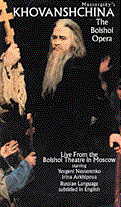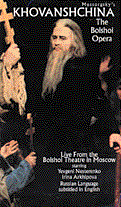Khovanshchina
Khovanshchina
Couldn't load pickup availability
Nesterenko, Arkhipova, Vedernikov, Raikov, Romanovsky; Simonov, cond.; Bolshoi Opera. Russian, with English subtitles. (1978). 181m. Color.
NTSC VHS ONLY
Robert Levine, reviewing in the San Francisco Chronicle
“a riveting operatic experience”
“Khovanshchina is one of Russian opera’s infrequently performed masterpieces, a work which has been gaining steadily in popularity in recent years. ‘The Khovansky Uprising’ (as the title is often translated) is a sprawling tale of the struggle for power in Russia at the beginning of the reign of Peter the Great. This performance, taped ‘live’ at the Bolshoi Opera in 1979, stars the great Russian bass Yevgeni Nesterenko as Dosifei, the Old Believer at religious and psychological war with the New Order, led by Prince Ivan Khovansky. The manipulative Khovansky is powerfully portrayed here by Alexander Vedernikov, another of the world’s great basses, little known outside of the Soviet Union. Marfa, one of Dosifei’s followers and a fortune teller, is sung by the legendary mezzo-soprano Irina Arkhipova in a performance of great authority and dignity. Russian opera at the Bolshoi is the genuine article, and the remainder of the cast is equally impressive, from the mistrusting Prince Galitsyn of Yevgeny Raikov to the clever, informing Shaklovity of Vladislav Romanovsky.
“The opera is presented complete–this is the only full-length performance of the work on videocassette–and the sumptuous sets and costumes are a feast for the eyes. Conductor Yuri Simonov leads the forces of the Bolshoi with great power and a complete understanding of the complicated score. Special praise must go to the much-acclaimed Bolshoi Chorus, which lives up to its reputation. From the opening strains, depicting dawn over Moscow, to the fortune-teller’s haunting vision of Galitsyn’s downfall and on to the finale in which the Old Believers go to their deaths rather than submit to the New Order, Khovanshchina is a riveting operatic experience, here vividly brought to life.”


